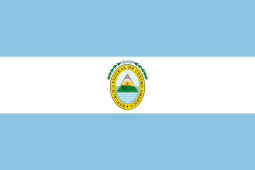Flag of Central America
Historical flags of Central America
 | |
| Use | National flag and ensign  |
|---|---|
| Proportion | 2:3 |
| Adopted | 21 August 1823[1] (modified in 1824) |
| Relinquished | 1839 |
| Design | A blue and white horizontal triband with the coat of arms of Central America in the center |
Central America was a unified nation at several points throughout its history, and while united, the country has used several national flags. The design of the Central American flag, a blue and white horizontal triband, was inspired by the flag of Argentina.[2][3]
Flags
| Flag | Adopted | Relinquished | Entity |
|---|---|---|---|
 | 1609 | 1701 | Captaincy General of Guatemala (Spain) |
 | 1701 | 1760 | |
 | 1760 | 1785 | |
 | 1785 | 15 September 1821 | |
 | 5 January 1822 | 1 July 1823 | Captaincy General of Guatemala (Mexico) |
 | 21 August 1823 | 1824 | United Provinces of Central America |
 | 1824 | 1839 | Federal Republic of Central America |
 | 1 November 1898 | 29 November 1898 | Greater Republic of Central America |
 | 13 December 1991 | present | Central American Integration System |
See also
- Flags of successor nations
- Flag of Costa Rica
- Flag of El Salvador
- Flag of Guatemala
- Flag of Honduras
- Flag of Nicaragua
References
Citations
- ^ Meléndez Chaverri 2000, p. 277.
- ^ Vítolo, Alfredo (15 February 2005). "Las Banderas Centroamericanas" [The Central American Flags]. La Nación (in Spanish). Archived from the original on 30 August 2009. Retrieved 22 October 2022.
- ^ "El Origen de las Banderas de Centroamérica, Inspiradas en la Bandera Argentina – Hipólito Bouchard" [The Origin of the Flags of Central America, Inspired by the Flag of Argentina – Hipólito Bouchard]. Puerto Vallarta News (in Spanish). 18 May 2010. Archived from the original on 8 January 2011.
Bibliography
- Meléndez Chaverri, Carlos (2000). José Matías Delgado, Prócer Centroamericano [José Matías Delgado, Central American Hero] (in Spanish). Vol. 8 (2nd ed.). San Salvador, El Salvador: Dirección de Publicaciones e Impresos. ISBN 9992300574. Retrieved 17 July 2022.
Further reading
- Horváth, Zoltán (12 August 2013). "Central America - Historical Unions and Federations". CRW Flags. Retrieved 22 October 2022.
- v
- t
- e
- Currency
- Elections
- Federal government
- Flag
- National anthem
- President
- Costa Rica
- El Salvador
- Federal District
- Guatemala
- Honduras
- Los Altos
- Nicaragua
- Claimed territories
 Category
Category











